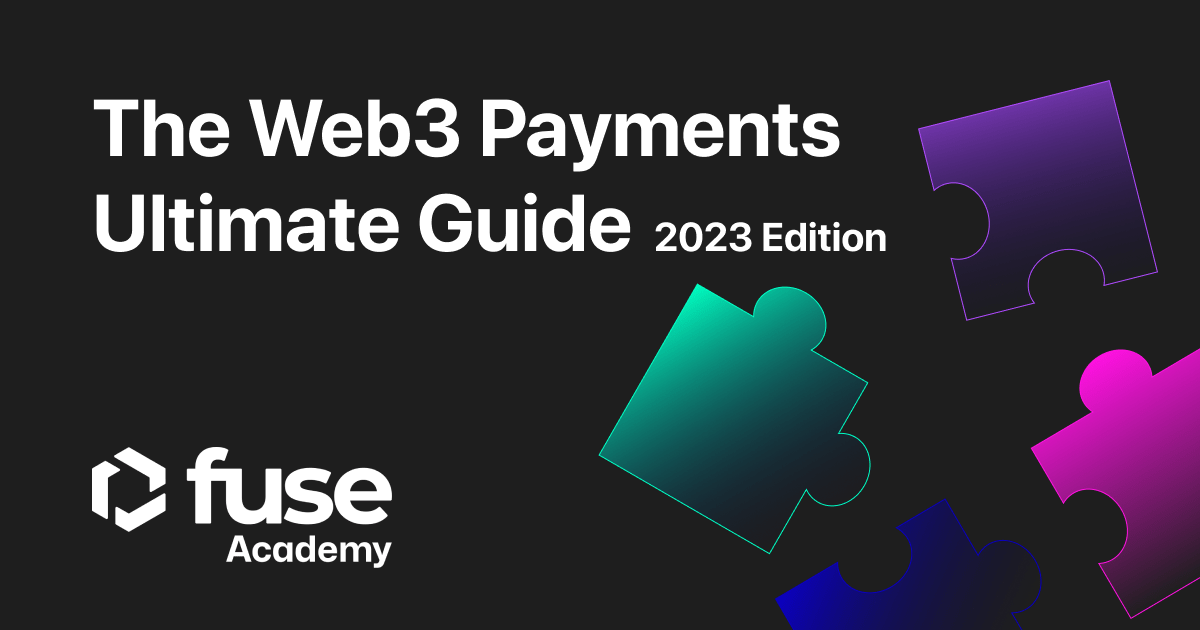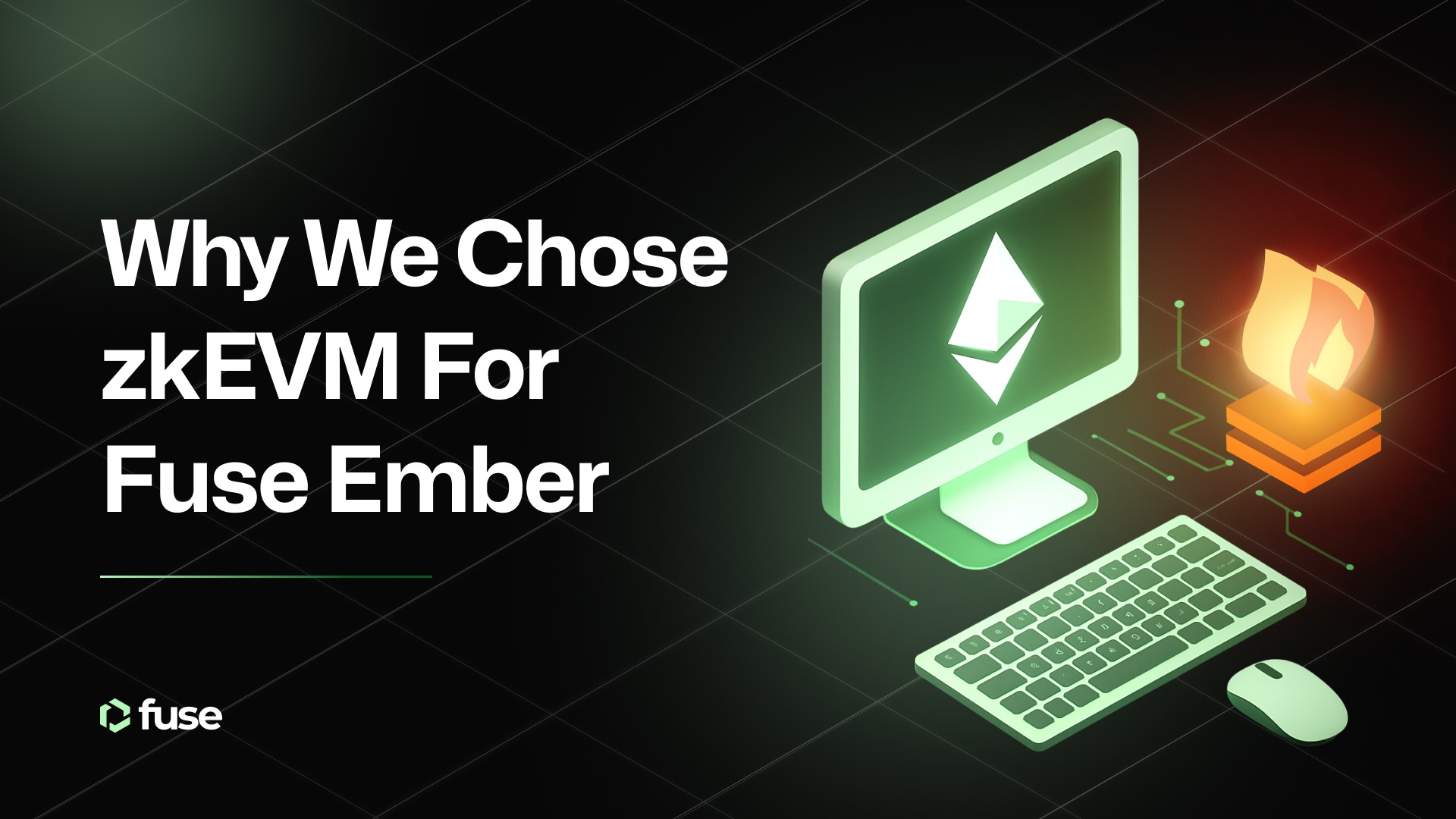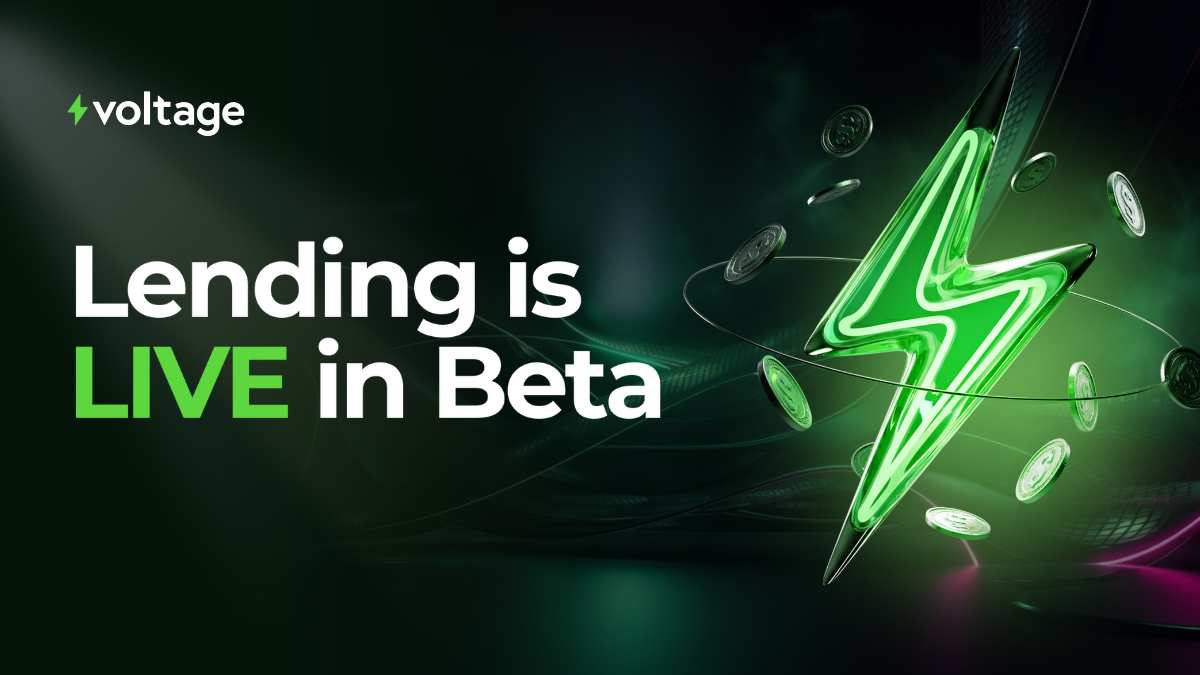With more and more businesses beginning to accept crypto and Web3 payments, it’s time to get on board and learn everything you can about this new way of conducting transactions. The cryptocurrency revolution has arrived, and it’s here to stay.
This guide will cover everything you need to know about making and receiving crypto payments, from what types of currencies are available to how to keep your assets safe. So let’s get started!
Table of Contents
- What is Web3?
- What are Web3 payments?
- Blockchain tech and the new age of finance
- DeFi and its benefits
- Top cryptocurrencies to use to pay for goods in 2023
- What can I buy using Web3 payments?
- Web3 payments for businesses
- Can any business accept crypto payments?
- Can I accept crypto payments on mobile?
- Getting started with Web3 payments
- Web3 payments are the future, but are we there yet?
- Cautions when using Web3 payment solutions
- Taxation on Web3 Payments
- Keep learning how to use crypto with Fuse Academy
What is Web3?
Before we dive into how Web3 payments are innovating finance as we know it, let’s first understand the term itself.
Web3 refers to the new age of decentralized internet applications built on a blockchain network. Web3 payments use this technology to facilitate the exchange of digital assets.
In this new age of the web, people not only can access and create content, code, assets, etc. But also own and control their digital rights. It is an exciting and growing field that has vast potential.
Web3 offers a wide range of potential applications—from creating financial ecosystems and providing identity management solutions to powering a revolution in gaming and digital art—allowing everyone, from individuals to large corporations, to benefit from secure opportunities.
What are Web3 payments?
Web3 payments are one of the most innovative and technologically advanced payment systems. Thanks to blockchain technology, they allow users to send, receive, and store digital assets securely.
Using a Web3 payments solution, we’re cutting off the middleman to our transactions – the banks, the payment processors, and the brokers. Web3 payments are entirely peer-to-peer and are built on trustless logical systems, meaning no one has to rely on a third party to facilitate the transaction.
They allow instantaneous transactions with low fees depending on the amount sent or received.
Read also: What is a Transaction on the Blockchain?
Blockchain tech and the new age of finance
Blockchain technology is the backbone of Web3 payments and cryptocurrencies.
Since the Bitcoin whitepaper was published in 2008, it opened up a door to a new age of financial transactions.
By being the first to use this technology to secure the transaction of data without a third party, the Bitcoin network and its cryptocurrency pushed forward Web3 payments and decentralized finance’s (DeFi) momentum.
Since then, more and more networks have been developed, taking Bitcoin’s initial mission and raising the bar. All kinds of transactions between parties can be even faster and cheaper, but it isn’t quickly done without compromising decentralization and security. There are; however, some innovative projects succeeding.
The Ethereum blockchain and its ETH coin are at the center of Web3 action today, with many chains, tokens, and decentralized applications (dapps) running or originating from it.
While the crypto space isn’t likely to be dominated by a single blockchain but has several networks interoperating, its primary and vital exploit revolves around people’s freedom.
DeFi and its benefits
Decentralized Finance, often called DeFi, is a new segment of web-based applications that use blockchain technology to allow users to access financial services. Take a look below at the reasons why DeFi is the future of finance:
- It removes the need for a centralized entity to control how or if we pay, get paid, get loans, trade, etc.
- DeFi also extends access to financial services to people worldwide – no matter their history, nationality, religion, or connections.
- Web3 payments are faster and cheaper than traditional payment methods, allowing users to send money quickly across the globe at a fraction of the cost of traditional markets.
- All transactions are cryptographically secure and stored on an immutable public ledger that is free for all users to see.
Read also: DeFi Crash Course: Learn about the future of money
Top cryptocurrencies to use to pay for goods in 2023
Although there are several cryptocurrencies, they were all created with different intentions of facilitating Web3 payments – such as FUSE.
Depending on the network the tokens are built on, transactions may take time and have high costs. Bitcoin, for example, would never be a successful, widely adopted means of payment due to its slow speed and high fees. It’s better suited as a store of value.
On the other hand, the Ethereum network and its side chains, like Fuse, BNB Chain, and Polygon, are leading crypto payments across Web3.
So, if you want to exchange assets directly with someone, you shouldn’t use any random crypto token.
Here are some of the best cryptocurrencies for financial transactions in 2023:
- Fuse (FUSE)
- Ethereum (ETH)
- Polygon (MATIC)
- Binance Coin (BNB)
Read also: What is the FUSE token, and why hold it?
Stablecoins
Besides the cryptocurrencies cited above, which are native tokens to their networks, there are also crypto tokens called stablecoins that are especially good for Web3 payments.
Stablecoins are tokens pegged to the value of a fiat currency like the US dollar, British pound, or Euro, thus making them less volatile and more suitable for Web3 payments.
If you’re looking to pay someone using Web3, stablecoins are a great choice. The most popular stablecoin on the Ethereum network is USD Coin (USDC), while the most popular one on the Fuse network is Fuse Dollar (FUSD). You can use each to quickly trade the chain’s coin for a dollar-pegged asset.
What can I buy using Web3 payments?
Cryptocurrencies can purchase various goods and services, from everyday items like groceries and clothes to high-end luxury items like cars and jewelry.
Not to mention all digital assets backed by blockchain technology, like blockchain games tokens, Metaverse lands, Music NFTs, etc.
As more businesses outside the crypto industry begin to invest in Web3 and crypto themselves, there will likely be an increase in products and services available for Web3 payments.
So far, organizations worldwide have reported investing in their crypto portfolios or launching a blockchain-related campaign. JPMorgan, Tesla, Nike, Dolce & Gabanna, and the NBA are only a few.
Web3 payments for businesses
According to a recent report, more than 75% of merchants who accept crypto as payment celebrate increased sales globally. Unsurprisingly, around a quarter of all online businesses are looking to embrace Web3 payments by 2025 – a number that will only grow as the benefits become widely known.
Although many are already familiar with the advantages of digital assets, specific factors make crypto especially attractive for businesses of different scales and industries.
But now, the real question. Is it cheaper than using Visa, Stripe, or Google Pay to accept digital payments as a merchant? Short answer – yes. The long answer – is yes, and it’s sometimes faster.
First of all, crypto transactions are not weighted on the transaction size. The fee is the same if a customer sends you $1 or $10,000. Second, the fees are around $0.001 per transaction on Fuse.
Sounds good. Well, there is more. Web3 payments are near instant and cross all global borders. A customer in India can buy goods from your business in California, and the payment would settle almost instantly, and the fees would be the same as if the customer was standing in front of you.
Why? Because it isn’t dragged through years of legacy finance software, most of which was designed before the internet. A blockchain is a ledger of transactions. It’s global, and it’s immutable. It operates 24 hours a day, 365 days a year, without the need for any human control to accept or approve transactions.
If you’re a business owner or entrepreneur that wants to embrace Web3 and crypto payments directly into a new or existing app, contact the Fuse team to find out how.

Build on Fuse Network
Fuse was designed to be friendly for blockchain & non-blockchain developers alike.
Can any business receive crypto payments?
Yes, any professional and any business worldwide can use Web3 payment solutions to receive cryptocurrencies from their clients – whoever they are.
Depending on your country, you may even get fiscal benefits from it.
All you need is basic industry knowledge, an internet connection, and a mobile phone or a computer.
It’s essential, however, to take professional advice on organizing your company’s connection to your Web3 wallets before jumping into it.
Can I accept Web3 payments on mobile?
Accepting crypto payments via a mobile app is possible using the Fuse and alternative tech stacks focussed on mobile. Mobile is arguably considered the holy grail in crypto, as developers know that end users increasingly use mobile devices to conduct online activities.
The critical benefit is reducing the cost of sales through embracing Web3 payments and achieving a global reach at launch.
Notable examples within the Fuse ecosystem show the application of accepting Web3 payments more clearly. For example, the Southeast Asian crypto wallet and exchange platform Bitazza forked the Fuse Wallet stack to build a consumer-facing crypto wallet that can accept crypto payments and is used by several merchants in Thailand.
If you’re a business owner or entrepreneur that wants to embrace Web3 and crypto payments directly into a new or existing application, contact the Fuse team to find out how.
Getting started with Web3 payments
Now that you’re familiar with using the innovative Web3 payment solutions. Here are the steps you need to take to get started:
1. Do your research
Before crossing the street, you must look both ways. That’s the same with everything in life and the same with using crypto.
Taking financial advice from anyone who is not a professional is risky and likely to lead you to losses. Even then, no one is foul-proof. That’s why it’s crucial to understand Web3 payments before making any decisions.
Learn as much as possible about the cryptocurrency market, decentralized applications, personal finances, economics, and how to manage your investments.
2. Understand what you need Web3 for
Why do you want to use crypto? Is it to pay for an NFT? Join your friends in a Web3 game. Send money to your family in a different country? To invest in a project? Maybe you want to buy a Tesla car? Or to allow customers to pay for goods in a futuristic way?
All of this is important so that you can choose the best blockchain, token, and wallet to use.
Security should also be kept in mind.
3. Create a Web3 wallet
After you’ve learned what Web3 payments are and the best crypto tokens to use, you’ll need to get a Web3 wallet – or several. That’s where you’ll store your digital assets like crypto and NFTs.
A wallet address is a unique string of numbers and letters assigned to it. They can be software, hardware, or even an online version. It’s also worth noting that you’ll need a different wallet address for each network you interact with.
Unless you use a centralized exchange like Binance or Huobi, you’ll be responsible for keeping your private keys and passwords. That’s different in a decentralized exchange like Sushi, though.
You’ll need to transfer your tokens to point B’s wallet address to get your money from point A to point B.
Here are some of the best wallets to get started with crypto:
- MetaMask: the leading online Web3 wallet for crypto and non-fungible tokens on Ethereum and EVM-compatible chains.
- Trust Wallet: a Web3 wallet for multiple cryptocurrencies.
- Ledger: a hardware wallet to keep assets stored offline.
4. Buy your first crypto
Once you’ve created your wallet address, you must swap your Fiat currency – such as dollars, euros, or pounds – for cryptocurrencies.
You can use a centralized (CEX) or decentralized exchange (DEX.) Some wallets also allow you to buy crypto directly with your credit or debit card.
5. Transact as you wish (no middleman involved)
With your wallet set, tokens stored, and enough knowledge, you’ll be ready to start making transactions on a blockchain.
Web3 payments are the future, but are we there yet?
Yes and no. As we’re only at the beginning of the development and acceptance of the technology, Web3 payments still come with limitations. Most networks have yet to deal with speed, security, and transaction fees successfully. But their most significant drawback is the need for more acceptance by merchants.
Cryptocurrency and blockchain-related concepts are complex and often have a terrible reputation. The general audience must readily understand their importance and impact on our traditional financial systems. Scams take place everywhere, not just in Web3.
And, of course, giant financial corporations that control and manipulate markets don’t want to lose their business models and decrease their revenue by promoting decentralization.
This is just the beginning of Web3 payments being used at scale around the globe. We expect to see more investment and development into Web3 solutions that will benefit individuals everywhere in the coming years.
Cautions when using Web3 payment solutions
Not all that glitters is gold; when you have the freedom and responsibility that blockchain allows you, there is plenty of room for mistakes. Therefore, everyone using crypto should do so with some safety tips in mind. Such as:
- Never share your private keys, and be careful with which websites you connect your wallet;
- Always double-check wallet addresses and network before sending any crypto;
- Don’t trust just any project claiming to be revolutionary and asking for your investment;
- Look out for scams of fake sales on social media;
- If you don’t own your keys, you don’t hold your crypto – centralized exchanges may disappear and take your crypto with them.
It’s the wild west out there. Be prepared, safe, and intelligent.
Taxation on Web3 Payments
Lastly, everyone making or spending money on crypto must know how it is taxed in their region. Most countries have already started legal regulation of digital assets and their exchanges, so you’ll have to pay taxes on your crypto income and capital gains.
But that’s different everywhere, so check the taxation laws in your home country and the countries you are dealing with. You may find some extra attractive benefits to it.
Some of the countries where there are no or little crypto taxations in 2023 (so far) include
- Portugal;
- Georgia;
- Malta;
- Belarus;
- Puerto Rico;
- El Salvador;
- Singapore.
Keep learning how to use crypto with Fuse Academy
Getting on board the DeFi train may be a bit difficult. However, there are benefits as far as the eye can see once you get the hang of it. That’s why it’s so important to educate yourself constantly and always be on top of what’s new in the industry.
With Fuse Academy articles, you learn about resources and tools to start investing, trading, and using Web3 payments properly.
This guide provides all the information about Web3 payments to get started with cryptocurrencies and decentralized finance.
Continue your path and learn more about Web3 and the Fuse Network
.svg)
.svg)











